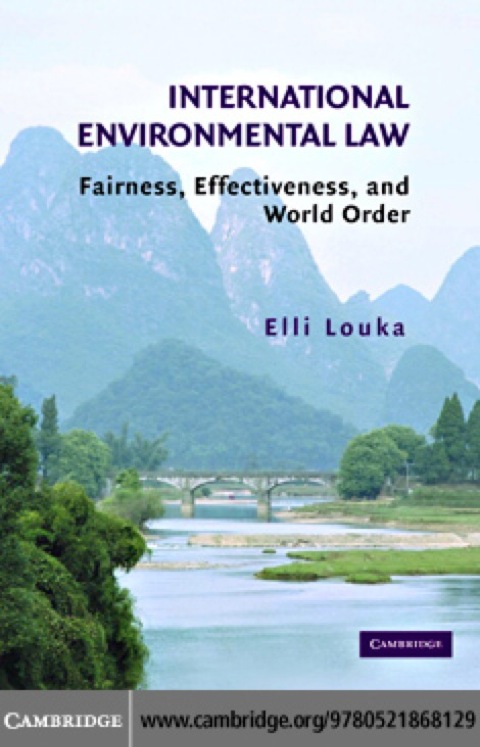Description
Efnisyfirlit
- Half-title
- Title
- Copyright
- Contents
- Foreword
- Abbreviations
- Introduction
- 1 Introduction to International Environmental Law
- 1 The World Community and International Law
- 1.1 International Law
- 1.2 States
- 1.2.1. Sovereignty
- 1.2.2. Wealth
- 1.2.3. Cooperation
- 1.3 International Organizations
- 1.4 Nongovernmental Actors
- 2 International Lawmaking Process
- 2.1 Treaties
- 2.2 Custom
- 2.3 Principles of Law
- 2.4 Other Sources
- 2.5 Content
- 3 Perspectives
- 3.1 Developed Countries
- 3.2 Developing Countries
- 4 Historical Evolution
- 4.1 Stockholm
- 4.2 Rio
- 4.3 Johannesburg
- 4.4 From Stockholm to Johannesburg
- 4.5 Case Law
- 5 Globalization and International Law
- 6 Principles
- 6.1 Sovereignty over Natural Resources
- 6.2 Obligation Not to Cause Damage
- 6.3 Principles of Preventive Action and Precaution
- 6.4 Polluter Pays Principle and Equitable Sharing of Cost
- 6.5 Sustainable Development
- 6.6 Equitable Utilization
- 6.7 Common but Differentiated Responsibilities
- 6.8 Human Rights
- 7 Settlement of Disputes
- 8 Monitoring and Enforcement
- 2 Foundations of International Environmental Law
- 1 Functions of Law
- 2 Foundations
- 2.1 Minimum Order
- 2.2 Equity
- 2.3 Effectiveness as Equity
- 2.4 Cost-Effectiveness
- 3 Regulation of Natural Resources
- 4 Enclosure of National Commons
- 5 Enclosure of Global Commons
- 5.1 Fisheries
- 5.2 Deep Sea-Bed Resources
- 5.3 Germplasm and Related Knowledge
- 5.4 Freshwater Resources
- 5.5 Air
- 5.6 Seas
- 5.7 Waste Management
- 5.8 National Biodiversity Resources
- 6 Enclosure of Global Commons and Global Welfare
- 7 International Instruments
- 8 Conclusion
- 3 Compliance and Governance Mechanisms
- 1 Environmental and Strategic Impact Assessment
- 2 State Obligations
- 2.1 Exchange of Information
- 2.2 Notification
- 2.3 Consultation
- 2.4 Reporting/Monitoring
- 3 Verification and Compliance
- 4 Right to Information and Participation and Access to Justice
- 4.1 International Instruments
- 4.2 Application of Right to Information
- 5 Conclusion
- 4 Marine Environment
- 1 State of Marine Environment
- 2 Integrated Coastal Zone Management
- 3 Evolution of International Instruments
- 3.1 Law of the Sea Convention
- 3.2 Pollution from Dumping
- 3.3 Regional Management
- 3.4 Pollution from Ships
- 3.5 Emergency Situations
- 3.6 Safety Regulations
- 4 Selected Regional Instruments
- 4.1 Protection of the Northeast Atlantic
- 4.2 Protection of the Baltic Sea
- 4.3 UNEP Regional Seas Program
- 5 Conclusion
- 5 Water Resources
- 1 State of Water Resources
- 2 Issues in Water Management
- 2.1 Allocation and Equity
- 2.1.1. Substantive Equity
- 2.1.2. Procedural Equity and Institutional Development
- 2.1.3. Principled Equitable Utilization or Ad Hoc Regionalism?
- 2.2 Efficiency and Quality
- 2.3 Integrated Water Resources Management
- 2.3.1. National
- 2.3.2. International
- 3 Case Law
- 4 International Instruments
- 5 Regional Instruments
- 5.1 Africa
- 5.2 Asia
- 5.3 Middle East
- 5.4 Europe
- 5.4.1. Suprabasin Instruments
- 5.4.2. Basin-Specific Instruments
- 5.5 American Region
- 5.5.1. United States–Canada
- 6 Conclusion
- 6 Fisheries Resources
- 1 State of World Fisheries
- 2 National Management of Fisheries Resources
- 2.1 Regulation
- 2.2 Privatization
- 3 International Management of Fisheries Resources
- 3.1 Law of the Sea Convention
- 3.2 Case Law
- 3.3 International Instruments
- 3.3.1. Agreement on Fisheries Management
- 3.3.2. FAO Code of Conduct for Responsible Fisheries
- 3.4 Regional Agreements
- 3.5 Case Studies
- 3.5.1. South East Atlantic Fisheries Organization (SEAFO)
- 3.5.2. South Pacific Forum Fisheries Agency (SPFFA) and Western and Central Pacific Commission (WCPC
- 3.5.3. North East Atlantic Fisheries Commission (NEAFC)
- 3.5.4. Northwest Atlantic Fisheries Organization (NAFO)
- 3.5.5. International Commission for the Conservation of Atlantic Tuna (ICCAT)
- 3.5.6. General Fisheries Commission of the Mediterranean (GFCM)
- 3.5.7. Commission for the Conservation of Antarctic Marine Living Resources (CCAMLR)
- 4 Conclusion
- 7 Biodiversity
- 1 Biodiversity Management
- 1.1 State of Biodiversity Resources
- 1.2 National and Transnational Protected Areas
- 1.3 Gene Banks
- 2 International Instruments
- 2.1 Biodiversity Convention
- 2.1.1. Biodiversity Protection
- 2.1.2. Resource Allocation
- 2.1.2.1. Market Value of Biodiversity
- 2.1.2.2. Bilateral Redistribution
- 2.1.2.3. Transnational Redistribution
- 2.1.2.4. Institutionalized Redistribution
- 2.2 Trade and Biodiversity
- 3 Protection of Habitats
- 3.1 World Heritage Sites
- 3.2 Forests
- 3.3 Wetlands
- 4 Regional Instruments
- 4.1 Europe
- 4.2 Africa
- 4.3 South East Asia
- 4.4 Antarctica
- 4.5 Other Regional Instruments
- 5 Protection of Species
- 5.1 Protection of Migratory Species
- 5.2 Protection of Whales
- 5.3 Protection of Seals
- 5.4 Other Agreements
- 6 Conclusion
- 8 Air Pollution
- 1 Ozone Depletion
- 1.1 Negotiating Process
- 1.2 Legislative Instruments
- 1.2.1. Protection of Ozone Layer
- 1.2.2. Regulation of Ozone-Depleting Substances
- 1.3 Conclusion
- 2 Climate Change
- 2.1 Negotiating Process
- 2.2 Legislative Instruments
- 2.2.1. Convention on Climate Change
- 2.2.2. Regulation of Greenhouse Gases
- 2.2.3. Market-Based Regulation of Greenhouse Gases
- 2.3 Conclusion
- 3 Transfrontier Air Pollution
- 3.1 Legislative Instruments
- 3.1.1. Convention on Transboundary Air Pollution
- 3.1.2. Regulation of Air Pollutants
- 3.2 Conclusion
- 9 Trade and Environment
- 1 World Trade Institutions
- 2 The Treaties
- 3 Dispute Settlement
- 3.1 General Agreement on Tariffs and Trade
- 3.2 Sanitary and Phytosanitary Measures
- 4 Intellectual Property Rights and Trade
- 4.1 Intellectual Property Rights Institutions and Trade
- 4.2 Intellectual Property Rights and Pharmaceuticals
- 4.3 Intellectual Property Rights and Genetic Resources
- 4.3.1. Letter of TRIPs
- 4.3.3. Seed Wars
- 4.3.4. TRIPs and Traditional Knowledge
- 4.3.5. TRIPs and Farmers’ Rights
- 5 Conclusion
- 10 Hazardous and Radioactive Wastes
- 1 State of International Waste Trade
- 2 State of Waste Management
- 2.1 Landfill/Geologic Disposal
- 2.2 Marine Disposal
- 2.3 Treatment
- 2.4 Incineration
- 2.5 Recycling and Reprocessing
- 3 International Instruments
- 3.1 Hazardous Wastes
- 3.2 Radioactive Wastes
- 4 National Regulatory Dilemmas
- 4.1 The United States
- 4.1.1. Management of Hazardous Wastes
- 4.1.2. Management of Radioactive Wastes
- 4.1.3. Management of Waste Trade
- 4.2 European Union
- 4.2.1. Management of Hazardous Wastes
- 4.2.2. Management of Radioactive Wastes
- 4.2.3. Management of Waste Trade
- 5 Conclusion
- 11 Liability and State Responsibility
- 1 Oil Pollution
- 2 Hazardous Materials Trade
- 2.1 CRTD Convention
- 2.2 HNS Convention
- 2.3 Liability for Waste Trade
- 3 Nuclear Energy
- 4 Liability for Damage to the Environment
- 5 State Responsibility
- 6 International Liability
- 7 Conclusion
- International Treaties and Other Instruments
- Cases
- Index





